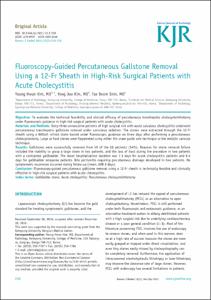Fluoroscopy-Guided Percutaneous Gallstone Removal Using a 12-Fr Sheath in High-Risk Surgical Patients with Acute Cholecystitis
- Keimyung Author(s)
- Kim, Young Hwan
- Journal Title
- Korean Journal of Radiology
- Issued Date
- 2011
- Volume
- 12
- Issue
- 2
- Abstract
- Objective: To evaluate the technical feasibility and clinical efficacy of percutaneous transhepatic cholecystolithotomy under fl uoroscopic guidance in high-risk surgical patients with acute cholecystitis. Materials and Methods: Sixty-three consecutive patients of high surgical risk with acute calculous cholecystitis underwent percutaneous transhepatic gallstone removal under conscious sedation. The stones were extracted through the 12-Fr sheath using a Wittich nitinol stone basket under fl uoroscopic guidance on three days after performing a percutaneous
cholecystostomy. Large or hard stones were fragmented using either the snare guide wire technique or the metallic cannula technique.
Results: Gallstones were successfully removed from 59 of the 63 patients (94%). Reasons for stone removal failure included the inability to grasp a large stone in two patients, and the loss of tract during the procedure in two patients with a contracted gallbladder. The mean hospitalization duration was 7.3 days for acute cholecystitis patients and 9.4 days for gallbladder empyema patients. Bile peritonitis requiring percutaneous drainage developed in two patients. No symptomatic recurrence occurred during follow-up (mean, 608.3 days). Conclusion: Fluoroscopy-guided percutaneous gallstone removal using a 12-Fr sheath is technically feasible and clinically effective in high-risk surgical patients with acute cholecystitis.
- Keimyung Author(s)(Kor)
- 김영환
- Publisher
- School of Medicine
- Citation
- Young Hwan Kim et al. (2011). Fluoroscopy-Guided Percutaneous Gallstone Removal Using a 12-Fr Sheath in High-Risk Surgical Patients with Acute Cholecystitis. Korean Journal of Radiology, 12(2), 210–215. doi: 10.3348/kjr.2011.12.2.210
- Type
- Article
- ISSN
- 1229-6929
- Appears in Collections:
- 1. School of Medicine (의과대학) > Dept. of Radiology (영상의학)
3. Research Institutues (연구소) > Institute for Medical Science (의과학연구소)
- 파일 목록
-
-
Download
 oak-aaa-03568.pdf
기타 데이터 / 243.6 kB / Adobe PDF
oak-aaa-03568.pdf
기타 데이터 / 243.6 kB / Adobe PDF
-
Items in Repository are protected by copyright, with all rights reserved, unless otherwise indicated.